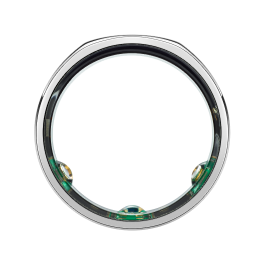Your heart rate variability (HRV) is one of the key indicators of your recovery status, overall health, and fitness level. Specifically, your HRV trend reflects how past days’ strain and rest levels are affecting your current recovery status.
In the Oura App, you’ll find a metric called HRV Balance, which contributes to your overall Readiness Score in your Oura App. HRV Balance captures how your autonomic nervous system (ANS) is trending over time. While HRV levels naturally fluctuate day-to-day, a key sign of health and recovery is a resilient HRV score. A score that rebounds after taking a hit or gradually improves over time is what to look for.
HRV is a highly personal measure, and your unique nervous system determines your HRV range. Some individuals have a wide range, with HRV values that vary widely, while others have a steady score. HRV Balance uses your personal baseline and allows you to see how you’re doing relative to your own optimal HRV.
LEARN MORE: What is the Average HRV?
How is HRV Balance Calculated?
HRV Balance is generated through a longer-term comparison of your current HRV trend and your personal baseline. More specifically, a rolling average of the past two weeks is compared to your baseline over the past three months. HRV Balance puts more weight on recent days to better reflect the fluctuations of your HRV.
Your Balance can fall into three categories:
- Optimal = Your recent HRV trend is on par or better than your average, which is usually a sign of good recovery.
- Good = Your recent HRV trend is slightly different from your average but still indicates you’re maintaining a good level.
- Pay attention = Your recent HRV trend is below your average, which can be a sign that your body or mind is under prolonged stress.
HRV Balance and HRV average highlight different patterns. Your nightly average reflects shorter-term changes in your HRV, such as early signs of illness, immediate reactions to workouts, or other factors that can have a day-long effect on a person’s recovery status.
HRV Balance, on the other hand, highlights the overall balance of your ANS over time. It captures the negative effects of prolonged stressors (e.g., overtraining, long-term stress, or multiple days of illness) and the positive impact of longer-term factors (e.g., recovery capacity, overall fitness).
HRV Balance reflects how your day-to-day patterns of stress and recovery balance out over weeks. If your balance leans more towards strain than recovery, your HRV will likely trend down. If you’re striking an optimal balance between pushing and rebounding, your HRV will maintain – or even improve – over time.
Which Patterns Matter?
HRV Balance allows you to set longer-term HRV goals. Maybe you’re aiming for a gradual increase in your average HRV by taking steps to improve your overall health and fitness. Or maybe you’re proactively avoiding downward trends—looking for imbalances that tell you it’s time to rest.
Regardless of your goal, you can keep an eye out for these patterns:
Decreasing HRV Balance May Indicate:
- Long-term stress: Prolonged stress can cause your HRV values to drop gradually, indicating that your body may need more recovery time.
- Impact of illness: Being sick can acutely drop your HRV. If it remains low, even after symptoms disappear, it may be a sign that your body needs more time to normalize.
- Disrupted sleep: Jet lag or inconsistent sleep can put a strain on your body. Over time, this can impact your ANS and will be reflected in declining HRV.
- Overtraining: If you complete a hard workout, it can quickly lower your HRV. As you recover, your HRV will rebound. If your HRV doesn’t return to baseline, you may be training too hard or too often. Your body may need more time to recover.
READ MORE: Manage Stress Using These Relaxation Tips
Static or Increased HRV Balance May Indicate:
- Optimal training: If your body is naturally rebounding from acutely lower days (e.g., after a hard workout), it’s a sign that your body is handling the training load well. In the long term, physical fitness can increase your HRV.
READ MORE: How to Train Better Using HRV
As you observe the changes in your HRV scores, keep in mind:
- HRV Balance only leverages nighttime HRV to capture your underlying physiological state. Daytime readings are more likely to reflect short-term stressors.
- HRV Balance is based on averages and will react more sensitively to individuals who have bigger fluctuations in their HRV readings.
- HRV can react to several factors simultaneously, meaning it may be difficult to pinpoint what caused any changes (e.g. overtraining, stress, prolonged illnesses combined). Being in touch with your daily score, and noting what habits are paired with your lowest HRV, can help you narrow down the key factors.
- HRV Balance requires a week of data before it will be reflected in your app.
HRV is an ever-evolving tool, so it’s important to check in with your body consistently. If your Balance is low, but you’re feeling good, then listen to your body, and get the most out of your days.





